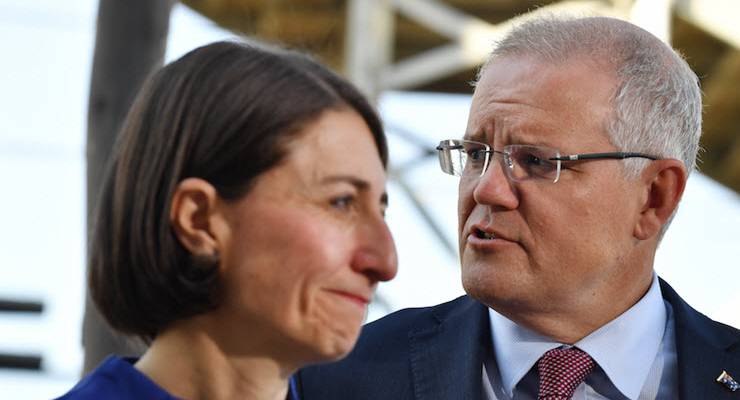
It’s hard to hear behind the noise of the attention economy’s insatiable demand for a catastrophising narrative — cases! Deaths! Fines! — but two-steps-forward, one-step back Australia is shuffling towards the Berejiklian-Chant strategy of vaccinating towards a post-COVID country.
Clearest sign? Morrison’s weekend pivot to hope, with the strong backing of the pro-lockdown-lite News Corp media. (A whopping “One million doses of hope” according to The Australian.)
The prime minister has lots of reasons to be thankful for the NSW women. By getting out in front on “living with COVID”, the NSW Liberal government has given Morrison the freedom to reposition himself as the responsible patriarch, reining them in, conveniently whitewashing his over-egged criticism of Victoria’s lockdown last year.
The state’s relentless day-in, day-out messaging is saving the Morrison government’s vaccination rollout, with NSW hitting 25% double-dosed on Friday and 50% single-dosed on the weekend. On current trends, the state will hit the magical 80% double-dosed by mid-November, and drag the country with it.
Australia’s been late getting there. And, right now, Indigenous communities in western NSW are paying the price. But it’s on track for the only timetable that matters for the PM — the 2022 federal election (which reporters with strong contacts in the PMO are predicting for March.)
Then, Morrison will be relying on his own hope: that voters will forgive slow starts and fumbles once the other side of the pandemic comes into focus.
Just three weeks ago political orthodoxy was sneering at the NSW call for a vaccine surge to counter the “national emergency” in south-western Sydney. Then, Morrison’s office was helpfully briefing reporters that the request had been met with a firm prime ministerial “No” in national cabinet.
Now? Morrison is claiming credit for the surge off the back of the Polish Pfizer doses.
The media, meanwhile, had been distracted by the theatre of police horses on the eastern suburbs beaches following the sudden crackdown announced at Saturday’s presser.
The announcement contradicted the state government’s traditional drop to News Corp: “Premier says no to police pleas for tighter lockdown” splashed The Weekend Australian. It’s not clear what happened between the drop and the cop, but Morrison has been happy to take the credit. (And given his transactional approach, the Saturday “crackdown” may not be unrelated to Sunday’s vaccine boost.)
The heart of the Saturday package was that classic announceable: fines!
In NSW, fines are ever less about restraining deviant behaviour than the taxing of it. According to the NSW Treasury, about 3.36 million fines were issued last financial year across all offences — that’s over one per household — with a total charge of $885 million.
In a year largely free of lockdowns, there were about 2000 COVID offences, worth about $3 million.
Like most of the Sydney (and now NSW) lockdown, the penalties reflect the legal principle of Anatole France: “The law, in its majestic equality, forbids rich and poor alike to sleep under bridges, to beg in the streets, and to steal their bread.”
The inequality — and the inequality of compliance — is entrenched in the Sydney divide between the lockdown in the 12 local government areas “of concern” and the rest of Greater Sydney. The major difference: for the 2.2 million people living inside the 12 it’s harder to work and compliance is more rigorously — and less empathetically — enforced.
It’s strongly Labor-voting (a proxy for disadvantage). By accident or design, Liberal-held seats are largely excluded. In Penrith City, the Labor-voting East Ward is included. Other wards in the Liberal-held seats of Penrith and Mulgoa are not.
Labor is returning the favour. On Insiders yesterday, Tony Burke (whose electorate covers the Canterbury-Bankstown hotspot) finger-pointed at Liberal-represented Bondi. Unfair? Sure. But a strong indication of how the two Sydneys are living a very different outbreak.
It’s a divide that challenges the state government strategy of easing restrictions where cases are light and vaccination is high. Can comfortable Sydney open up while disadvantaged Sydney is screwed shut?
But the alternative is asking now one in four fully vaccinated voters (soon one in three, then one in two) to stay home just to set a good example. As compliance gets harder to impose, watch for the pivot to “vaccine passports” as an attempt to square that tricky circle.








The prime minister of Sydney, just not western Sydney, will come up with some kind of scare campaign.
It will need to be a big one if this drags on into the fire season, which it will given the total incompetence of the NSW squatocracy.
“But the alternative is asking now one in four fully vaccinated voters (soon one in three, then one in two) to stay home just to set a good example.” Clearly the author is not taking any notice of the fact that a) vaccinated epople are catching and transmitting the virus, even if it is largely only killing the unvaccinated and b) there are a number of people, mostly young adults, who are not eligible for or have not had access to vaccination in many parts of the country.
The only reason that the majority of deaths is in unvaccinated people is because the majority of people are unvaccinated.
95% of deaths from Covid19 in the UK are vaccinated.
100% vaccinated with AZ leaves the 15% that it doesn’t work for in an ICU.
How good was getting the cheap one?.
90% plus efficacy for AZ against hospitalisation, ratty, pretty much the same as for Moderna and Pfizer (both only slightly higher) although longevity of efficacy likely to fall in favour of AZ. So there’s that.
Codswallop
Your usual acute & penetrating analysis.
What do you do when not spluttering over a keyboard?
Anything?
I wonder if our Prime Minister gave his Polish counterpart assurances that these vaccine doses would not be administered to people with contrary views to his (the Polish leader) on LGBT and Women’s Rights issues
One would be confident of a crusty nativist conservative connection with Poland, like Hungary, via our now global political grifters revolving round LNP, NewsCorp, IPA and the Catholic Church; both Hungary and Poland have been targeted and encouraged by Anglosphere xenophobes and libertarians to withdraw and crash the devil incarnate, the EU.
“The media, meanwhile, had been distracted by the theatre of police horses on the eastern suburbs beaches”
Yes, just a distraction, but it’s not a great look, I’ll admit, having people sunning themselves. Glad you pointed this out.
Interestingly, there was some early example of political considerations in relation to who was locked down. 3 Sydney LGAs were included on the basis of extensive breakouts, and a nearby 4th, Randwick, which just happens to return Labor candidates, was added although the published evidence at the time did not support it (but later clearly supported all of Sydney being locked down, properly)
You bet that political leanings have been taken into account in determining who is locked down and who isn’t.
I suspect Gladys is looking to free up the vaccinated from a whole batch of LGAs which will, purely coincidentally (cough) be Liberal held seats.
The Insular Peninsula has never been more so – after all, they are so much more worthy.
I’m grateful that Poland has sent us some vaccines, but surely there are other Third World banana republics that need them more than we do?
They have sold us them to make a quid. I am entirely confident that the use-by dates have not been tampered with and that the temperature conditions required have been maintained through the Polish summer.